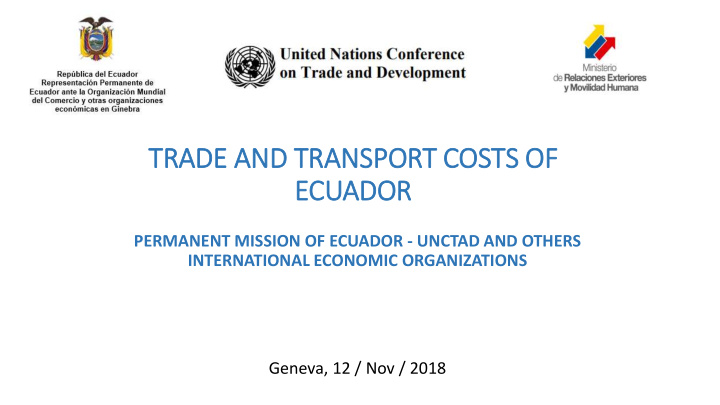



TRADE AND TRANSPORT COSTS OF ECUADOR PERMANENT MISSION OF ECUADOR - UNCTAD AND OTHERS INTERNATIONAL ECONOMIC ORGANIZATIONS Geneva, 12 / Nov / 2018
LOGISTIC COSTS OF EXPORTS April – June 2018 (A) GOODS VALUE (B) (B/A) SELECTED PRODUCTS CONTAINER 40 FT LOGISTIC COST LOGISTIC % X (THOUSAND USD) (THOUSAND USD) COST 24% 9,4 1,5 16% BANANA 25% 161,7 2,2 1% SHRIMP 9% 66,8 1,8 3% PRESERVED TUNA 5% 53,1 2,0 4% COCOA BEANS 2% 44,5 1,6 4% FROZEN FISH 35% 9,1 OTHERS 100% TOTAL SELECTED NON OIL EXPORTS Logistic cost has decreased 3% in the last year to 5,4% (B) Not include freight cost Source: Logistic Coordination of Ministry of Foreign Trade and Investments - Ecuador
Source: World Bank
Source: World Bank
AVERAGE LOGISTIC COST OF NON OIL EXPORTS OF ECUADOR (USD / Container 40 FT) RUS: 2,700 EU: 4,600 USA: 1,500 TUR: 5,500 JAP: 1,800 CHN: 1,400 PAN: 800 NIG: 5,000 COL: 1,100 INDO: 2,600 BRA: 2,600 PER: 1,100 AUS: 3,900 CHL: 1,800 ARG: 3,200 Source: PROECUADOR
INTERNAL TRANSPORT COST IN ECUADOR GROUND COST: USD 1,500 Example for transporting 3,000 Kg a distance of 1,000 Km Source: Cámara de Transportes pesados de Pichincha y empresas transportistas colombo ecuatorianas.
South American Ports • Limited potential of hubs in the region • Low transhipment traffic (0,5% world share) • There are not wide terrestrial connections nor high volumes of cargo. • Low volume of trade, high costs and location, the ports of the South American Atlantic are better owned. • Ports should to integrate at regional level in order to take advantage of regional products. • There is an increase in the export of port services between the countries of the Pacific coast • Public investment has been made in port and land infrastructure. • Regional coordination of transport and infrastructure investment policies is needed to enhance regional viability rather than attempting to have a logistics hub in each country. Source: J. Hoffman CEPAL 2000. El Potencial de Puertos Pivotes en la Costa del Pacífico Sudamericano
Source: TradeMap
SVE TRADE COST* • The use of technology reduce the trade related cost, however the biggest challenge is the rise in the technology gap between developing and developed economies. • The implementation of tools that reduce trade costs, as the single window for customs process, requires the use of digital tools in order to be effective. • There are several factors that determine the trade cost related to transport, they are: 1) Distances 2) Economies of scale 3) Imbalances 4) Type and value of goods 5) Competition 6) Port characteristics *CTD, Dedicated sesions (WTO), November 1st 2018
SVE TRADE COST 2* • In the practice, private administration of ports gives better results. • It is a good idea to foster competence between ports, in some cases the alternative is to specialize them. • Currently there is a concentration in the global container shipping industry, few companies provide most of the service. There is also a rise in the efficiency through the increase of the ships size. • It is important policy makers follow up the changes in the shipping market to formulate adequate responses.
Recommend
More recommend